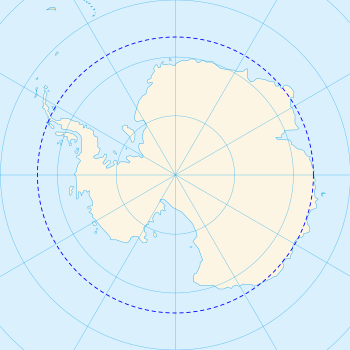Antarctic Circle
This article relies largely or entirely on a single source. (August 2010) |
This article needs additional citations for verification. (August 2010) |


The Antarctic Circle is one of the five major circles (or parallels) of latitude that mark maps of the Earth. For 2012, it is the parallel of latitude that runs 66°33′49.9″ (or 66.56387°) [1] south of the Equator.
Description
The area south of the Antarctic Circle is known as the Antarctic, and the zone immediately to the north is called the Southern Temperate Zone. The equivalent line of latitude in the northern hemisphere is the Arctic Circle.
Every place south of the Antarctic Circle experiences a period of twenty-four hours' continuous daylight at least once per year, and a period of twenty-four hours' continuous night time at least once per year. That is to say, there is at least one whole day during which the sun does not set, and at least one whole day during which the sun does not rise. On the Antarctic Circle these events occur, in principle, exactly once per year, at the December and June solstices respectively. This happens because the Earth's axis is tilted, by approximately 23.5 degrees, relative to ecliptic (the plane of the Earth's orbit around the sun). At the southern winter solstice, the southern hemisphere is tilted away from the Sun to its maximum extent, and the region of permanent darkness reaches its northern limit; at the southern summer solstice, the southern hemisphere is tilted towards the Sun to its maximum extent, and the region of permanent sunlight reaches its northern limit.
In practice several other factors affect the appearance of continuous day or night, the most important being atmospheric refraction, the altitude of the observer above sea level, mirages, and the fact that the sun is a sphere rather than a point. Mirages on the Antarctic continent tend to be even more spectacular than in Arctic regions, creating, for example, a series of apparent sunsets and sunrises while in reality the sun remains under the horizon.
Due to gradual changes in the tilt of the Earth's axis, the Antarctic Circle is slowly moving. See circles of latitude.
Geography and demographics
The continent of Antarctica forms a land mass covering much of the area within the Antarctic Circle. There is no permanent human population on Earth south of the Antarctic Circle. There are, however, several Antarctic research centers from various nations that are inhabited by teams of scientists that rotate on a seasonal basis. In previous centuries, some semi-permanent whaling stations were established on the continent and some of the whalers would live there for a year or more. At least three children have been born in Antarctica, albeit in stations north of the Antarctic Circle. See Demographics of Antarctica.
Starting at the Prime Meridian and heading eastwards, the Antarctic Circle passes through:
See also
- Arctic Circle
- Equator
- Antarctic Convergence
- Solstice
- Obliquity of the Ecliptic
- Tropic of Cancer
- Tropic of Capricorn

